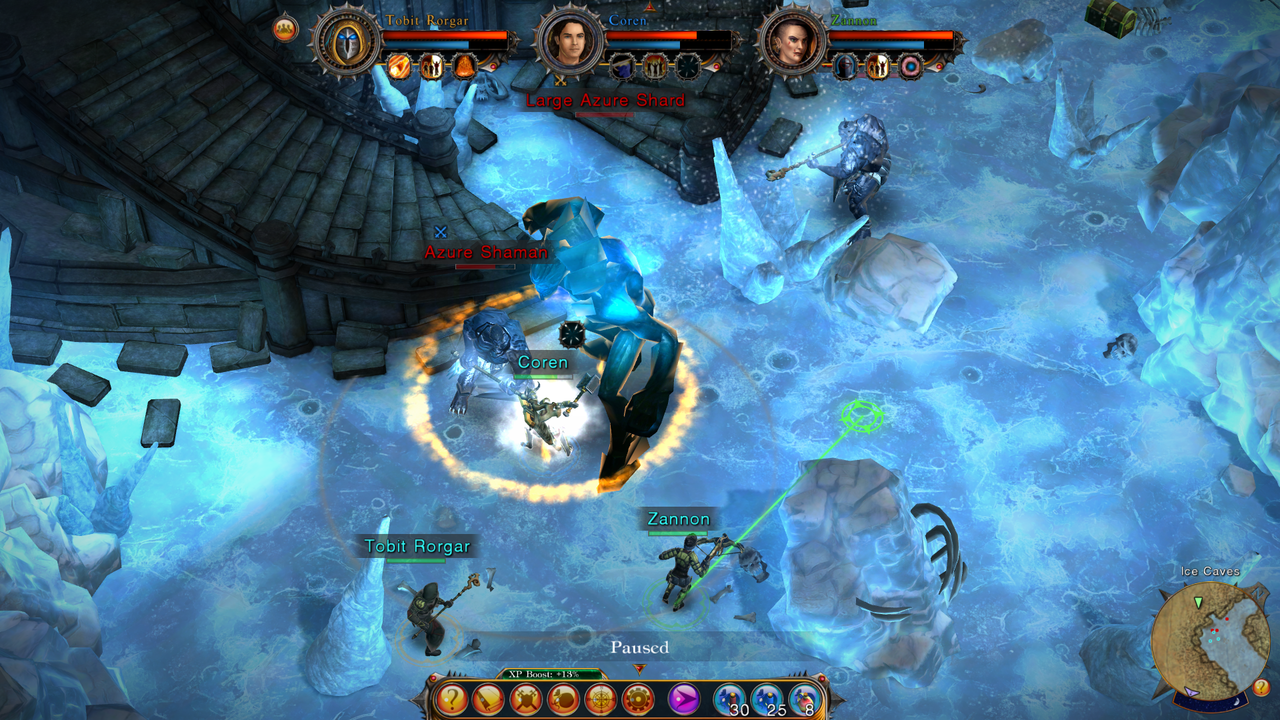The resurgence of isometric RPGs is in full force now, thanks to the likes of Pillars of Eternity, Divinity: Original Sin and Baldur’s Gate: Siege of Dragonspear. Smaller, AA companies are able to bring back a style of RPG that has long been dormant, seen as an anachronism for years in the wake of cinematic storytelling and AAA production values. Indie games have been also following this trend, with a number of titles attempting to capture the isometric experience in their own way. One game in this mold is Ember, an isometric RPG by developer N-Fusion Interactive. Ember touts itself as an homage to the classics, which for the studio is ten years in the making. The final product promises a 30-hour RPG experience. In execution, however, Ember struggles to showcase relevance in an ever competitive RPG market.
Ember has a few good things going for it at first. For one, the world itself is very pretty. N-Fusion Interactive has done a marvelous job creating a sort of constant, open world divided into several different zones, all rendered in three dimensions. The legacy of isometric RPG’s is strong in Ember, mostly on a technical level with the camera perspective. The world design is also varied enough to be interesting, despite using the same sort of template for each area; twisted corridors in a treasury, a maze-like swamp, even a few caves and crypts here and there give the world different territories, even if they share the same designs.
Ember also has a very robust backstory as a world, in particular how the world has molded itself around the eponymous Embers to begin with. In fact, the narrative of the game is at its strongest when these Embers take center stage. The Embers are technically living beings but are used as jewelry and sources of power by the major races. What is interesting in the political and cultural dynamics that is shown regarding the trade and use of Embers by these races, which hints at a more political game being played in the background of the story.

I say hints at, because in the end, the player's character, a resurrected being known as the Lightbringer is not a part of that story. The background lore, despite stuck in the same mold as the likes of R.A Salvatore, is rich with great ideas that could have made Ember stand out as an RPG. Instead, Ember falls back on a crutch of clichés of Salvatore that hint at a better world than there is, becoming another derivative setting to slog through.
It is not really hard to classify Ember as being derivative. The biggest problem with the game is ultimately its brevity. Everything in Ember is designed to be fast and forward for the main plot, which leaves a lot of the side content to feel inadequate to the experience. There are about fifty or so sidequests, and most of them could be identified as fetch quests. The others tend to be dripping in cliché as well. One example is early in the game, where the Lightbringer must take care of rats in the cellar of a peasant. The old rats in the cellar quest has been an RPG joke for years, and other games have been playful with the joke each time. Oblivion, Dragon Age, even Bloodborne subvert the cliché by parodying or making light of the quest. Ember, however, plays it straight; you kill the rats, you get a reward, another quest in your log is completed.
There is no fourth wall breaking, no wink to the audience at how ridiculous the rat quest is. Even if it is a quest you expect, it is a quest that no one takes seriously from a narrative point of view. If it was added as an homage to classic titles like Baldur’s Gate, the point of the quest in Baldur’s Gate was to show a weak, untested adventurer starting out small with a cliché. Here, it makes the Lightbringer, a powerful being from another age, clean out someone’s house for a meager reward.
It also doesn’t help that characters you meet fall into the same clichés rather easily due to how paper thin they are. We get pampered, prissy nobles, Scottish Dwarves, sage-like Shepard’s, who are wise beings that herd sheep and are attuned with nature, and wise-cracking, unfunny bandits who accost the player for toll money at almost every turn. Even companions have few character traits attached to them. Save for a few original ideas, such as Giants who were forced to leave their homeland after a great war or a friendly Goblin King, Ember falls back on the tropes of fantasy pretty hard, which makes it harder to distinguish from its brethren.

The quest design is not much help either. Outside of relying on fetch quests for the bulk of the adventure, the main questlines are often devoid of meaningful choice and consequence. One example has you bargaining with a Necromancer for something needed for to the Lightbringer, a bargain that has “boss battle” written all over it. Unfortunately, you can’t avoid doing the Necromancer’s bidding, the game forces the player to continue on with the story as planned, going on a few more missions before returning to the wizard and finally fighting him in battle.
It’s the kind of stale railroading that some RPGs get accused of heavily these days. In many of these accusations, it’s minor narrative choices that change the flavor of such encounters; the choices matter not because of plot reasons, but because of the narrative upwards to the plot, making the choices self-contained. Ember, however, is much less subtle about it. Outside of a few side-quests, Ember doesn’t even have the illusion of choice presented to it. Most quests, including main quests, only have one or two dialogue options followed by a fight or two.
The game also gets monotonous at this pace, and this is also hurt by the other aspects of its design. One of the biggest problems was the fixed-camera; forcing the players to constantly click on the edge of their screen to keep moving. Camera orientation also can be messed with in a combat situation, but it requires playing the game in the pause and play style to do so. Compound the fact that you never can click on the whole party at the same time- you only control the Lightbringer- and combat situations can go one of two ways; you are stationary, or you click and drag your companions around so they can fight.
In truth, staying stationary is the easier of the two options, and only in a few boss fights did movement in combat really matter. The pause-and-play style of most isometric RPGs is designed for tactics and clever thinking to overcome insurmountable odds, but it's rarely used for that purpose here. In fact, one of the problems with the game's design is its own pathfinding, where characters refuse to move in tight corridors because the Lightbringer or another companion is blocking their path. It makes combat a chore in a lot of situations, a long, boring chore.

Crafting is also heavily emphasized, with a majority of what you pick up being either loot or crafting materials. The amount of options and recipes found for crafting is staggering, and it is clear that N-Fusion took a lot of time to implement the system as a major feature for Ember. The problem though is you find enough high-powered items to keep playing without crafting weapons or armor. The only items you may need are consumables like health and mana potions, otherwise crafting is a non-factor for most of the game. Add to this a rather poor inventory management system, crafting becomes less important than it is made out to be, which is a shame because of how in-depth it can become.
Level progression is also very simple; with four different stats to track with two points per level to place in stats. Statwise, Ember is simple and easy to pick up, although it does get rather simple to min-max statistics for the particular build you wish to make. All special abilities, however, are tied to your equipment- from healing to fireballs, power attacks, and area-of-effect attacks- all of your skills are based on the weapon and armor you wear.
This inherently is not a bad thing. In fact, the system is somewhat smooth as it allows players to customize their characters even further. What complicates the system is the randomness attached to it. You are not guaranteed a specific ability unless you spend a fortune on a corresponding rune found only in the hands of a few merchants. Outside of that, even crafting weapons and armor yields random results, and some abilities will always be more powerful or useful than others throughout the game.
A lot of these problems with Ember seem very minor, but they begin to add up when considering the overall experience. Compound this with the weak quest lines and interesting but ultimately forgettable main story, it sorts of regulates Ember to just another RPG that struggles to show itself as a dominant force.
Ember plays it safe in many of its design choices, and in its wake is a safe, but ultimately forgettable, RPG. The value proposition is about right for the experience, but that doesn’t make Ember stand out in any way. Perhaps others may find the game more appealing in the long run than I did, but in the end, Ember is just a flickering spark or two slowly dying out in the wind; the good ideas put into the game are buried under questionable and derivative design choices.
Ember was played on the PC (Affiliate) via Steam for a total of sixteen hours. A review code of the game was provided by the publisher.
Review Summary
Ember is just a flickering spark slowly dying out in the wind; the good ideas put into the game are buried under questionable and derivative design choices.
(Review Policy)Pros
- Seamless World...
- Robust Crafting System...
- Good Background Lore...
Cons
- ...with Little Quest Variety.
- ...that is Rarely Used In-Game.
- ...Muddled by Cliched Storytelling.
Have a tip, or want to point out something we missed? Leave a Comment or e-mail us at tips@techraptor.net







